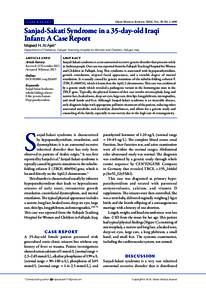وثيقة
Sanjad-Sakati syndrome in a 35-day-old Iraqi infant : A case report.
المعرف
DOI 10.5001/omj.2024.09
المصدر
Oman Medical Journal, v. 39, no. 1, e600 p. [1-3].
الدولة
Oman
مكان النشر
Muscat
الناشر
Oman Medical Specialty Board.
ميلادي
2024-01-01
اللغة
الأنجليزية
الموضوع
الملخص الإنجليزي
Sanjad-Sakati syndrome is a rare autosomal recessive genetic disorder that presents solely
in Arabian people. Our case was reported from the Fallujah Teaching Hospital for Women
and Children in Fallujah, Iraq. This syndrome is associated with hypoparathyroidism,
growth retardation, atypical facial appearance, and a variable degree of mental
retardation. It is usually caused by genetic mutations of the tubulin-folding cofactor E
(TBCE; 604934), which is located on the 1q42.3 chromosome. This case was confirmed
by a genetic study which revealed a pathogenic variant in the homozygous state in the
TBCE gene. Typically, the physical features of this case involve microcephaly, long and
narrow face, beaked nose, deep-set eyes, large ears, thin lips, long philtrum, micrognathia,
and small hands and feet. Although Sanjad-Sakati syndrome is an incurable disease,
early diagnosis helps with appropriate palliative treatment of the patient, reducing other
associated metabolic and electrolyte disturbances, and allows for a genetic study and
counseling of the family, especially in our society due to the high rate of consanguinity
ISSN
1999-768X (Print)
2070-5204 (Electronic)
قالب العنصر
مقالات الدوريات

